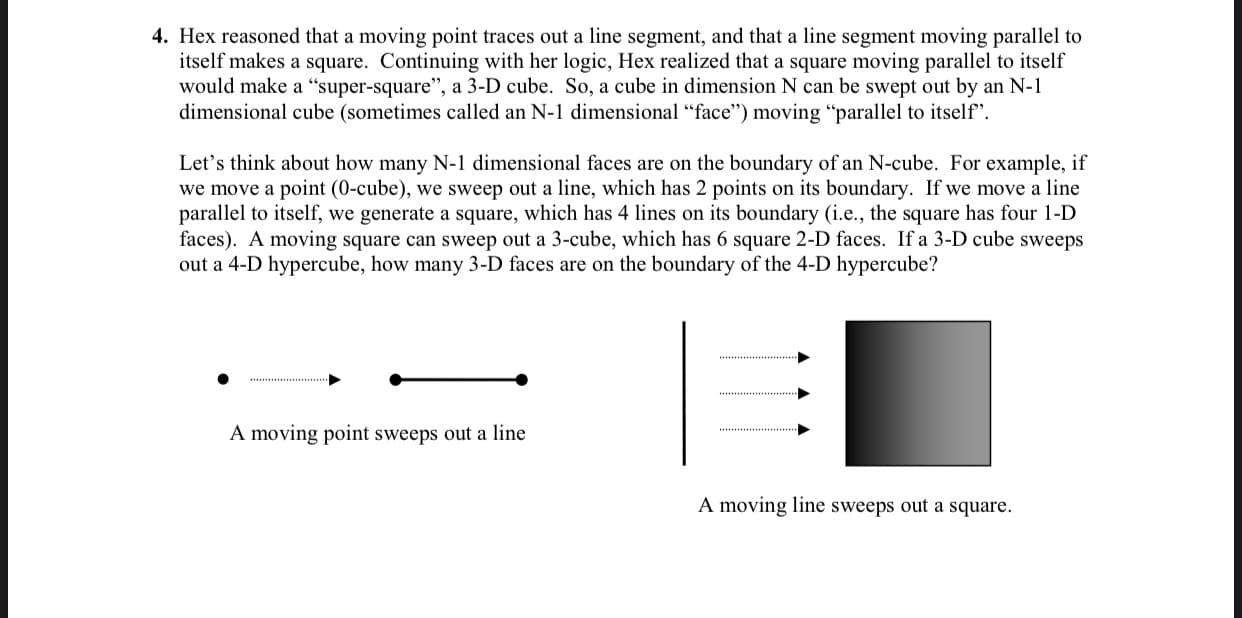Hex reasoned that a moving point traces out a line segment, and that a line segment moving parallel to itself makes a square. Continuing with her logic, Hex realized that a square moving parallel to itself would make a "super-square", a 3-D cube. So, a cube in dimension N can be swept out by an N-1 dimensional cube (sometimes called an N-1 dimensional "face") moving "parallel to itself". Let's think about how many N-1 dimensional faces are on the boundary of an N-cube. For example, if we move a point (0-cube), we sweep out a line, which has 2 points on its boundary. If we move a line parallel to itself, we generate a square, which has 4 lines on its boundary (i.e., the square has four 1-D faces). A moving square can sweep out a 3-cube, which has 6 square 2-D faces. If a 3-D cube sweeps out a 4-D hypercube, how many 3-D faces are on the boundary of the 4-D hypercube? .. A moving point sweeps out a line A moving line sweeps out a square.
Hex reasoned that a moving point traces out a line segment, and that a line segment moving parallel to itself makes a square. Continuing with her logic, Hex realized that a square moving parallel to itself would make a "super-square", a 3-D cube. So, a cube in dimension N can be swept out by an N-1 dimensional cube (sometimes called an N-1 dimensional "face") moving "parallel to itself". Let's think about how many N-1 dimensional faces are on the boundary of an N-cube. For example, if we move a point (0-cube), we sweep out a line, which has 2 points on its boundary. If we move a line parallel to itself, we generate a square, which has 4 lines on its boundary (i.e., the square has four 1-D faces). A moving square can sweep out a 3-cube, which has 6 square 2-D faces. If a 3-D cube sweeps out a 4-D hypercube, how many 3-D faces are on the boundary of the 4-D hypercube? .. A moving point sweeps out a line A moving line sweeps out a square.
Linear Algebra: A Modern Introduction
4th Edition
ISBN:9781285463247
Author:David Poole
Publisher:David Poole
Chapter2: Systems Of Linear Equations
Section2.4: Applications
Problem 16EQ
Related questions
Topic Video
Question

Transcribed Image Text:Hex reasoned that a moving point traces out a line segment, and that a line segment moving parallel to
itself makes a square. Continuing with her logic, Hex realized that a square moving parallel to itself
would make a "super-square", a 3-D cube. So, a cube in dimension N can be swept out by an N-1
dimensional cube (sometimes called an N-1 dimensional "face") moving "parallel to itself".
Let's think about how many N-1 dimensional faces are on the boundary of an N-cube. For example, if
we move a point (0-cube), we sweep out a line, which has 2 points on its boundary. If we move a line
parallel to itself, we generate a square, which has 4 lines on its boundary (i.e., the square has four 1-D
faces). A moving square can sweep out a 3-cube, which has 6 square 2-D faces. If a 3-D cube sweeps
out a 4-D hypercube, how many 3-D faces are on the boundary of the 4-D hypercube?
..
A moving point sweeps out a line
A moving line sweeps out a square.
Expert Solution
This question has been solved!
Explore an expertly crafted, step-by-step solution for a thorough understanding of key concepts.
This is a popular solution!
Trending now
This is a popular solution!
Step by step
Solved in 2 steps with 2 images

Knowledge Booster
Learn more about
Need a deep-dive on the concept behind this application? Look no further. Learn more about this topic, advanced-math and related others by exploring similar questions and additional content below.Recommended textbooks for you

Linear Algebra: A Modern Introduction
Algebra
ISBN:
9781285463247
Author:
David Poole
Publisher:
Cengage Learning

College Algebra
Algebra
ISBN:
9781305115545
Author:
James Stewart, Lothar Redlin, Saleem Watson
Publisher:
Cengage Learning

Algebra & Trigonometry with Analytic Geometry
Algebra
ISBN:
9781133382119
Author:
Swokowski
Publisher:
Cengage

Linear Algebra: A Modern Introduction
Algebra
ISBN:
9781285463247
Author:
David Poole
Publisher:
Cengage Learning

College Algebra
Algebra
ISBN:
9781305115545
Author:
James Stewart, Lothar Redlin, Saleem Watson
Publisher:
Cengage Learning

Algebra & Trigonometry with Analytic Geometry
Algebra
ISBN:
9781133382119
Author:
Swokowski
Publisher:
Cengage